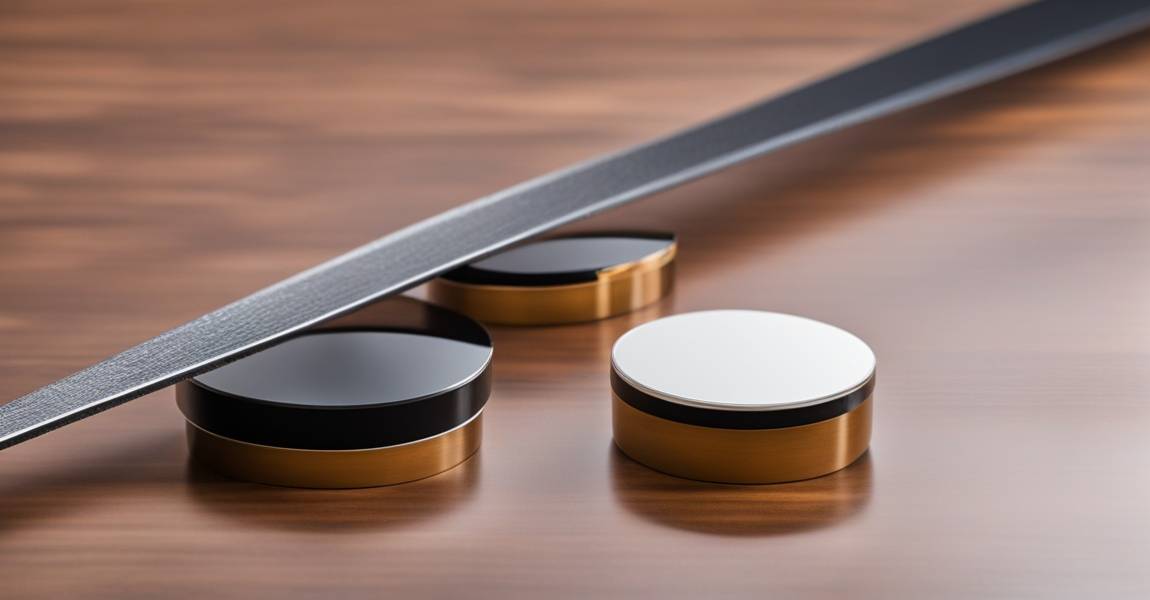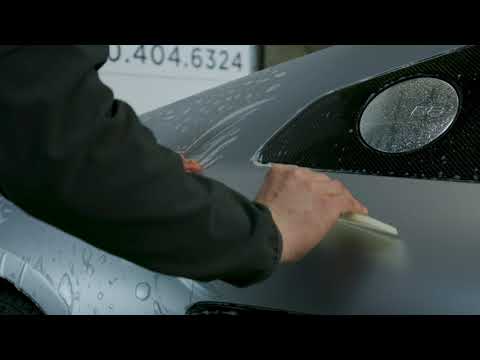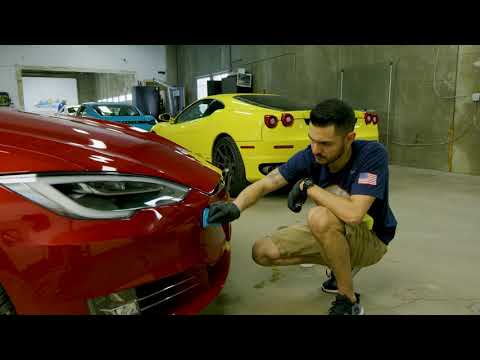Did you know graphene coatings can last over 5 years on your car? This makes them a standout choice in car care. As car owners look for the best protective coatings, the graphene vs ceramic debate heats up. Knowing more about these options will help you decide the best way to keep your car looking great.
Ceramic and graphene coatings are popular among car lovers and experts for good reason. This article dives into each coating’s details, like what they are and what they’re made of. You’ll learn about their benefits, how they compare, and how they’re used. This info will help you pick the right protection for your car.

Key Takeaways
- Graphene coating and ceramic coatings offer unique advantages for car protection.
- Durability with graphene is much higher and varies significantly between the two, with graphene coatings lasting longer.
- Hydrophobic properties of graphene prevent contaminants from settling.
- Application processes differ and can affect overall results.
- Understanding cost implications is crucial in choosing the right option.
- Both coatings have professional-grade applications available.
Table Of Contents
- Introduction to Car Coatings
- What Is A Graphene Coating?
- What Is A Ceramic Coating?
- Benefits of Graphene Coating
- Benefits of Ceramic Coating
- Graphene vs Ceramic Coating for Cars: A Comparison
- Differences in Application Processes
- Graphene Coating vs Ceramic Coatings: Cost Analysis
- Common Misconceptions About Graphene and Ceramic Coatings
- Real-World Applications and User Experiences
- Conclusion: Ceramic or Graphene?
- FAQ’s
Introduction to Car Coatings
Car coatings are key to protecting your vehicle. They guard against environmental damage, UV rays, and contaminants. These layers are crucial for keeping your car’s paint looking good and strong.
Ceramic and graphene coatings are among the top choices. They offer long-lasting protection for your car’s paint and are more affordable. Graphene coatings are known for their unmatched durability and performance.
Each coating product has its own benefits and ways to apply it. It’s important for car lovers and owners to know the differences in the advantages over ceramic coatings. Learn more by reading this detailed article.
Choosing the right car coating boosts your vehicle’s paint life. It shields against scratches, color fading, and rust. Knowing about graphene ceramic coating and ceramic coatings helps you choose the best protection for your car.
What Is A Graphene Coating?
Graphene coating is a ground-breaking product in the auto detailing world. Knowing what graphene is, is key. It’s made of a single layer of carbon atoms in a honeycomb pattern. This special structure makes it very durable and flexible.
Definition and Composition of Graphene
The definition of graphene is important in the world of coatings at the molecular level. Its build gives it incredible strength, over 200 times stronger than steel. This makes it bond well with car surfaces. Car lovers prefer it for this. The graphene composition also provides great protection. Plus, it’s light and conducts heat well, making it less prone to damage.
Key Features of Graphene Coating
Graphene coating has unique qualities that make it stand out. Some of these include:
- Durability: Graphene coatings last 5 to 7 years, making them much more durable than others.
- Hydrophobic properties: It has a high contact angle, stopping water from staying on the surface.
- Scratch and abrasion resistance: Its strength helps it resist scratches, protecting the finish of your vehicle.
- Self-cleaning features: It stays cleaner, meaning less washing.
- UV and corrosion resistance: It keeps your vehicle safe from harmful elements while keeping its shine.
Graphene coatings are trusted by professional detailers worldwide, demonstrating their value. As more people learn about graphene’s advantages, using it for car care becomes vital. For more details on how graphene compares to ceramic coatings, check this comparison.
What Is A Ceramic Coating?
Ceramic coating is a top-notch way to protect your car’s paint. It bonds chemically with the car’s surface, forming a strong layer. This layer boosts both durability and looks. Learning about ceramic’s definition and elements helps us understand its protective power.
Definition and Composition of Ceramic Coating
The core of ceramic coating is silicon dioxide (SiO2) and other silicates. Once applied, it forms a semi-permanent shield. This shield fends off dirt, grime, and UV rays. Its molecular build keeps it strong over time, benefiting both car lovers and daily users.
Key Features of Ceramic Coating
The main features of ceramic coating make it great for boosting and safeguarding a car’s look. Important qualities include:
- Hydrophobic Properties: Water beads up and glides off, simplifying upkeep.
- Chemical Resistance: Shields against road salt, bird waste, and more.
- Longevity: It lasts 2 to 5 years, based on how well it’s applied.
Proper care is essential to extending the benefits of a ceramic coating. This web resource dives deeper into how it compares to other market options.
Benefits of Graphene Coating
Graphene coatings are a top pick for car lovers looking for the best vehicle protection. Knowing what these advanced coatings offer helps you choose the right care for your car.
Durability and Longevity
One big plus of graphene coating is how long it lasts. Some even keep your car safe for up to ten years. This comes from graphene’s strong structure, protecting against scratches, chips, and weather damage.
This makes it better than the usual ceramic coatings, offering longer protection for your car.
Resistance to UV Rays and Corrosion
Another key benefit of graphene oxide graphene coating is its protection against sun damage and rust. It protects your car, keeping it looking new. Plus, it stops water spots and etching better than many other coatings.
This kind of corrosion resistance shields your car from harmful environmental damage.
Ease of Application and Maintenance
Graphene coatings are also easy to apply. They require less prep and drying time, which is great for both DIY fans and pros. Maintaining a graphene coating is easy, simplifying your life.
| Feature | Graphene Coating | Ceramic Coating |
|---|---|---|
| Durability | 5-10 years | 3-5 years |
| Resistance to UV Rays | High | Moderate |
| Corrosion Resistance | Excellent | Good |
| Ease of Application | Less preparation needed | More preparation needed |
| Maintenance Frequency | Low | Moderate |
Benefits of Ceramic Coating
Ceramic coatings are popular in car protection. They offer great advantages at a good price. Compared to graphene, ceramic is more affordable, making it a top choice for those looking for paint protection on a budget. Learn more by reading this article 10 Benefits of Ceramic Car Coating.
Cost-Effectiveness
Ceramic coating is a cost-effective option. Depending on the formula and brand, prices range from $50 to $90 per 30ml. It’s a budget-friendly way for car owners to protect their vehicles.
Ceramic coatings’ durability is impressive, too. They can last up to 3 years, which means great value over time.
Availability and Variety of Coating Products
There is a wide range of ceramic coatings on the market. This variety means you can find one to meet your specific needs. Whether you’re using them for a professional application or a DIY project, there’s a product for you.
With many options, you can pick one that fits your budget and style of application.
Protective Features Against Contaminants
Ceramic coatings protect well against things like bird droppings and tree sap. They also stop dirt and road grime. The coatings create a strong barrier to avoid scratches and etches.
This protection keeps your car looking good for longer. A well-done ceramic coating doesn’t just enhance your car’s look. It also guards against environmental damage.

Graphene vs Ceramic Coating for Cars: Durable Comparison
Ceramic coatings and graphene coatings differ a lot in durability, water-repellence, and handling heat. Knowing these differences helps pick the best protection for your car.
Is Graphene Better Than Ceramic Coating?
Graphene coatings are generally considered superior to ceramic coatings in terms of durability, chemical resistance, and heat resistance, offering superior protection for vehicle surfaces. However, they are newer, often more expensive, and less widely available than ceramic coatings. The choice between the two depends on specific needs, preferences, and budget.
Durability and Scratch Resistance
Graphene coatings outperform ceramic ones in how long they last and resist damage. They are stronger, more flexible, and better at keeping scratches and chips away, providing advantages over ceramic coatings. Professional-grade ceramic coatings are also strong but not as good against scratches. Graphene lasts up to 5 years or more. Ceramic gives 2 to 3 years of cover if maintained well.
Hydrophobic Properties
Keeping your car looking clean is easier with graphene coatings because they’re excellent at repelling water. This means dirt and grime slide right off. Ceramic coatings are hydrophobic, too, but might not work as well in very wet conditions and can show water spots.
Thermal Management
Graphene coatings stand out in protecting against heat. They lower how hot surfaces get, important for parts of the car that get really warm. This helps keep the coating and the car’s paint in good shape. Graphene does better than ceramic here, making it a top choice for high heat situations.
| Feature | Graphene Coatings | Traditional ceramic coatings |
|---|---|---|
| Durability | 5-10 years | 2-3 years |
| Scratch Resistance | High | Moderate |
| Non-polar materials | Excellent (water beading) | Good |
| Thermal Management | Enhanced | Standard |
Differences in Application Processes
When we compare ceramic or graphene, we see they’re quite different. Particularly in how you prepare and how much work they take. Knowing these differences helps you pick the right protection for your car.
Preparation Requirements for Each Coating Type
To get a vehicle ready for coating, both graphene and ceramic need a clean and debris-free surface. Sometimes, you might even need to polish the car. Graphene is simpler to prepare, needing fewer steps. But ceramic coatings ask for more, including deep cleaning and often several layers for that perfect look. This means you’ll spend more time getting things ready.
Time and Labor Considerations
The time it takes to apply coatings varies. Graphene gets the job done quicker, letting you see great results fast. Ceramic coatings are very protective but need more time to apply and cure. So, you’ll have to plan more and might need professional help. It’s important to know these things when choosing a coating. They impact how well it works and how long it lasts.
Graphene Coating vs Ceramic Coatings: Cost Analysis
When choosing between graphene and ceramic coatings for your car, cost is key. Each type has different pricing based on its benefits and lifespan. Knowing the prices helps you pick the right one for your budget and needs.
Price Ranges of Graphene Coatings
Graphene coating costs usually range from $70 to $100 for 30ml. This price might seem steep at first. But, the cost of graphene coatings matches their cutting-edge technology and the long-lasting protection they offer. Their ability to resist scratches and damage from the environment can make them worth the extra cost.
Price Ranges of Ceramic Coatings
Ceramic coatings are generally priced between $50 and $90 for a 30ml bottle. They are seen as a more affordable choice for those wanting dependable protection without the high cost. Though less expensive upfront, these coatings may not last as long or offer the special qualities graphene does.
| Coating Type | Price Range (30ml) | Longevity | Key Features |
|---|---|---|---|
| Graphene Coating | $70 – $100 | Up to 10 years | Scratch-resistant, superior water repellency, effective heat dissipation |
| Ceramic Coating | $50 – $90 | 2 – 5 years | Durable protective layer, UV protection, easier to clean |
Think about what your vehicle needs, the weather it deals with, and how much you can spend. For expert advice, talk to local pros. A good place to start is Colorado Clear Bra, call them at 720 404 6324. They’ll help you choose the best coating for your car.

Common Misconceptions About Graphene and Ceramic Coatings
As cars evolve, so do misconceptions about graphene and ceramic coatings. Knowing these myths helps car owners pick the best paint protection.
Is Graphene Coating Overhyped?
Some believe graphene coatings don’t meet their claims. This doubt comes from lots of marketing. But science backs graphene’s effectiveness. It’s better in lasting, water resistance, and performance compared to traditional options. Clearing up misconceptions about graphene shows its true value.
Are Ceramic Coatings Obsolete?
Graphene’s rise makes people question ceramic coatings’ place. Yet, ceramics are still valuable for car protection. They are cost-effective, have many product options, and protect well against dirt. The ceramic coating debate shows both have unique perks for car enthusiasts.
| Feature | Graphene Coating | Ceramic Coating |
|---|---|---|
| Durability | Higher resistance to wear and tear | Lasts 2-3 years under normal conditions |
| Hydrophobic-Properties | Superior water repellency | Excellent but slightly less effective |
| Application Ease | Requires professional installation | Can be DIY-friendly |
| Cost | Generally, a higher initial investment | More cost-effective options are available |
Real-World Applications and User Experiences
Graphene and ceramic coatings are popular in the real world. Many car owners talk about how well these coatings work. They point out the performance and protection the coatings give.
Case Studies of Graphene Coating in Action
Graphene coatings have shown great results in real-world use. For example, users find the Turtle Wax Graphene product excellent for removing bug splats. This is a challenge with many car waxes. It makes maintaining a vehicle’s look easier, especially after a car wash.
Reports also say graphene coatings can protect for up to five years. They keep the car’s finish glossy with a hardness of 10 H for three to four years, offering years of protection.
Testimonials on Ceramic Coating Effectiveness
Vehicle owners also share their experiences with ceramic coatings. The Meguiars Hybrid Ceramic Wax is known for its long-lasting protection. One user noted their Mazda CX-5 stayed protected for nearly two years, with the vehicle mostly kept in a garage.
User testimonials highlight ceramic coatings’ cost-effectiveness versus expensive professional applications. The ease of applying these waxes by hand is a big plus. This simplicity and effectiveness make ceramic coatings a top choice for many.
| Product | Type | Approx Cost | Durability | User Feedback |
|---|---|---|---|---|
| Turtle Wax Graphene | Liquid Wax | $33 | 5 years | Excellent bug removal |
| Turtle Wax Graphene | Spray Flex Wax | $24 | 5 years | High gloss finish |
| Meguiars Hybrid Ceramic Wax | Ceramic Spray Wax | $17 | 2 years | Easy application, cost-effective |
Both types of car paint protection coatings offer benefits. Yet, the choice depends on what you need and like. It’s wise to read user experiences before making a decision.
Conclusion: Ceramic or Graphene?
In the debate on car coatings, graphene and ceramic stand out for their unique benefits. Your choice depends on your budget, what you expect from the coating, and how much effort you will put into maintenance. Ceramic coatings are known for lasting longer than car wax and sealants. They protect against UV rays and bird droppings, making them reliable for regular use.
On the other hand, graphene coatings are gaining fans for their endurance and water-repelling features. They do well in harsh weather and better protect car paint, which means cars might not need new coats as often. Despite graphene’s higher upfront cost, its impressive qualities make it a top-notch choice.
When comparing graphene and ceramic, both enhance your car’s look and lifespan. Keeping up with maintenance will make sure these coatings keep your car in great shape. For professional help or if you have questions about these coatings, reach out to Colorado Clear Bra. They can help you with your specific needs. Contact us today!
FAQ’s
What Is The Main Difference Between Graphene And Ceramic Coating For Your Vehicle?
Graphene coatings use graphene, offering top durability and water-repellency. Ceramic coatings, mainly made of silicon dioxide, have strong chemical resistance but last shorter.
How Long Do Graphene And Ceramic Coatings Last?
With good care, graphene coatings can last more than five years, up to ten. Ceramic coatings last around 2-5 years, depending on how well they’re applied and maintained.
Are Graphene Coatings Worth The Investment Compared To Ceramic Coatings?
Despite being pricier, ranging from $70 to $100 for 30ml, graphene coatings’ longer life and better protection make them a good buy for those wanting maximum car protection.
Which Coating Is Easier To Apply: Graphene Or Ceramic?
Applying graphene coatings is simpler, needing less preparation and quicker curing time. Ceramic coatings need more prep and several layers for application.
What Are The Hydrophobic-Properties Of Graphene And Ceramic Coatings?
Graphene coatings excel at water repellency, allowing water to bead and slide off easily. Ceramic coatings also repel water, but they are not as effective under harsh conditions.
How Do The Costs Of Graphene And Ceramic Coatings Compare?
Ceramic coatings, costing $50 to $90 for 30ml, are more budget-friendly. Graphene coatings, at $70 to $100 for 30ml, are pricier but offer more for the money.
What Types Of Auto Owners Benefit From Using Graphene Coatings?
Owners looking for long-lasting paint protection and less maintenance find graphene coatings ideal due to their enhanced durability and easy care.
Do Ceramic Coatings Offer Reliable Protection For Vehicles?
Yes, despite graphene’s popularity, ceramic coatings provide strong protection and gloss, being a cost-effective option for many owners.
Can I Apply Graphene Or Ceramic Coatings Myself?
DIY options are available for both. However, follow the application instructions closely for the best outcome. Graphene is generally easier to work with than ceramic.
What Advantages Do Graphene Coatings Offer Over Traditional Waxes And Sealants?
They last longer, better resist UV rays and corrosion, and need less care than conventional waxes and sealants, which require more regular reapplication.




